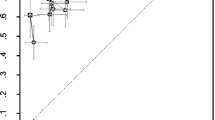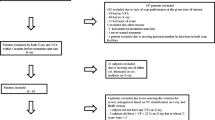Abstract
The current study was undertaken to evaluate the clinical utility of DVA, a system for imaging the lateral spine on the Lunar Prodigy densitometer. DVA images were obtained and bone density of the lumbar spine and proximal femur measured in 297 subjects (272 women), aged 64±13 years. The images were classified as: normal (N) if no fractures were detected and all vertebrae between T6 and L4 were visualized, fracture (F) if any vertebra had a fracture (defined as 25% or more reduction in the vertebral height) even if some of the other vertebrae could not be visualized, and un-interpretable (U) if at least one of the vertebra between T6 and L4 could not be classified and no fractures were detected in the visualized vertebrae. A subset of 66 patients also had standard radiographs of the thoracic and lumbar spine. Compared to radiographs, DVA had a 95% sensitivity to detect fractures and 82% specificity (to exclude them). Among all 297 subjects studied, DVAs were interpretable in 87%. They were classified as N in 204 (68%), F in 55 (19%) and U in 38 (13%). The reasons for un-interpretability were: scoliosis, scapular or rib shadow, severe arthritic changes and multiple vertebral compression fracture with severe spinal deformities. Only 11% of F subjects gave a history of a vertebral fracture, and only 56% of F subjects met the BMD criteria for osteoporosis (T score <−2.5). These results indicate that adding DVA, a low radiation and relatively low cost "point of service" procedure, to BMD measurement provides the clinician with a more comprehensive fracture risk assessment than that afforded by clinical evaluation and BMD measurement alone.





Similar content being viewed by others
References
Black DM, Arden NK, Palermo L, Pearson J, Cummings SR (1999) Prevalent vertebral deformities predict hip fractures and new vertebral deformities but not wrist fractures. Study of Osteoporotic Fractures Research Group. J Bone Miner Res 14:821–828
Melton LJ 3rd, Atkinson EJ, Cooper C, O'Fallon WM, Riggs BL (1999) Vertebral fractures predict subsequent fractures. Osteoporos Int 10:214–221
Lindsay R, Silverman SL, Cooper C, Hanley DA, Barton I, Broy SB, Licata A, Benhamou L, Geusens P, Flowers K, Stracke H, Seeman E (2001) Risk of new vertebral fracture in the year following a fracture. Jama 285:320–323
Kotowicz MA, Melton LJ 3rd, Cooper C, Atkinson EJ, O'Fallon WM, Riggs BL (1994) Risk of hip fracture in women with vertebral fracture. J Bone Miner Res 9:599–605
Ross PD, Genant HK, Davis JW, Miller PD, Wasnich RD (1993) Predicting vertebral fracture incidence from prevalent fractures and bone density among non-black, osteoporotic women. Osteoporos Int 3:120–126
Rea JA, SteigerP, Blake GM, Fogelman I (1998) Optimizing data acquisition and analysis of morphometric X-ray absorptiometry. Osteoporos Int 8:177–183
Rea JA, Steiger P, Blake GM, Potts E, Smith IG, Fogelman I (1998) Morphometric X-ray absorptiometry: reference data for vertebral dimensions. J Bone Miner Res 13:464–474
Rea JA, Li J, Blake GM, Steiger P, Genant HK, Fogelman I (2000) Visual assessment of vertebral deformity by X-ray absorptiometry: a highly predictive method to exclude vertebral deformity. Osteoporos Int 11:660–668
Rea JA, Chen MB, Li J, Blake GM, Steiger P, Genant HK, Fogelman I (2000) Morphometric X-ray absorptiometry and morphometric radiography of the spine: a comparison of prevalent vertebral deformity identification. J Bone Miner Res 15:564–574
Rea JA, Chen MB, Li J, Marsh E, Fan B, Blake GM, Steiger P, Smith IG, Genant HK, Fogelman I (2001) Vertebral morphometry: a comparison of long-term precision of morphometric X-ray absorptiometry and morphometric radiography in normal and osteoporotic subjects. Osteoporos Int 12:158–166
Rea JA, Blake GM, Fogelman I (2001) Development of a phantom for morphometric X-ray absorptiometry. Br J Radiol 74:341–350
Ferrar L, Jiang G, Barrington NA, Eastell R (2000) Identification of vertebral deformities in women: comparison of radiological assessment and quantitative morphometry using morphometric radiography and morphometric X-ray absorptiometry. J Bone Miner Res 15:575–585
Ferrar L, Jiang G, Eastell R (2001) Short-term precision for morphometric X-ray absorptiometry. Osteoporos Int 12:710–715
Edmondston SJ, Singer KP, Day RE, Price RI, Breidahl PD (1997) Ex vivo estimation of thoracolumbar vertebral body compressive strength: the relative contributions of bone densitometry and vertebral morphometry. Osteoporos Int 7:142–148
Genant HK, Li J, Wu CY, Shepherd JA (2000) Vertebral fractures in osteoporosis: a new method for clinical assessment. J Clin Densitom 3:281–290
Steiger P, Cummings SR, Genant HK, Weiss H (1994) Morphometric X-ray absorptiometry of the spine: correlation in vivo with morphometric radiography. Study of Osteoporotic Fractures Research Group. Osteoporos Int 4:238–244
Lang T, Takada M, Gee R, Wu C, Li J, Hayashi-Clark C, Schoen S, March V, Genant HK (1997) A preliminary evaluation of the lunar expert-XL for bone densitometry and vertebral morphometry. J Bone Miner Res 12:136–143
Greenspan SL, von Stetten E, Emond SK, Jones L, Parker RA (2001) Instant vertebral assessment: a noninvasive dual X-ray absorptiometry technique to avoid misclassification and clinical mismanagement of osteoporosis. J Clin Densitom 4:373–380
Jones G, White C, Nguyen T, Sambrook PN, Kelly PJ, Eisman JA (1996) Prevalent vertebral deformities: relationship to bone mineral density and spinal osteophytosis in elderly men and women. Osteoporos Int 6:233–239
Jackson SA, Tenenhouse A, Robertson L (2000) Vertebral fracture definition from population-based data: preliminary results from the Canadian Multicenter Osteoporosis Study (CaMos). Osteoporos Int 11:680–687
Schousboe JT, DeBold CR, Bowles C, Glickstein S, Rubino RK (2002) Prevalence of vertebral compression fracture deformity by X-ray absorptiometry of lateral thoracic and lumbar spines in a population referred for bone densitometry. J Clin Densitom 5:239–246
Acknowledgements
This study was supported by the grant AR42739/4A2 S1 from the National Institutes of Health and an unrestricted educational grant from the Fred and Susan Novy Family Foundation. The authors wish to thank Gina Keys and William Wilson for performing the DVA scans and Anca Guiu and Deepti Singh for help with data processing.
Author information
Authors and Affiliations
Corresponding author
Additional information
This study was presented in part at the ISCD Annual Meeting and Scientific Session, 13–16 February 2002, in Atlanta and at the Fifth International Symposium on Clinical Advances in Osteoporosis, 6–9 March 2002, in Honolulu.
Rights and permissions
About this article
Cite this article
Vokes, T.J., Dixon, L.B. & Favus, M.J. Clinical utility of dual-energy vertebral assessment (DVA). Osteoporos Int 14, 871–878 (2003). https://doi.org/10.1007/s00198-003-1461-9
Received:
Accepted:
Published:
Issue Date:
DOI: https://doi.org/10.1007/s00198-003-1461-9




